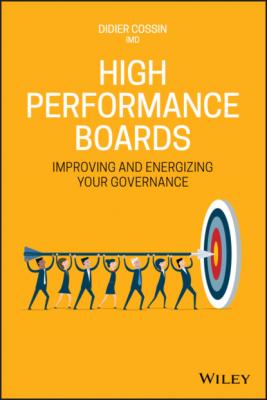ТОП просматриваемых книг сайта:
High Performance Boards. Didier Cossin
Читать онлайн.Название High Performance Boards
Год выпуска 0
isbn 9781119615699
Автор произведения Didier Cossin
Издательство John Wiley & Sons Limited
Figure 2.1 Transformational Leadership Principles
In general, transformational leaders:
empower followers and nurture them through change;
become a strong model for their followers;
create a vision for the organisation;
act as change agents for a new direction within the organisation; and
become social architects.
Should We Trust Leaders?
The transformational leadership model relies strongly on trust, and in particular on employees trusting their leaders. Yet many inspiring and transformative leaders have changed their organisations for the worse instead of for the better. And in recent years, trust in leaders has been affected by a string of events that have negatively impacted many people's lives and well-being.
One example is the nuclear leak in 2011 at the Fukushima plant of the Tokyo Electric Power Company (TEPCO). Back in 2007, an earthquake had caused a small nuclear leak, and the company's president, Tsunehisa Katsumata, was asked to retire. However, Katsumata then became chair of TEPCO, despite his previous failure to adequately manage this risk.
Another case concerns Chinese company Sanlu, which raised protein levels in baby milk by using chemicals including melamine. The firm's top management was aware of this and informed the board, which included directors from New Zealand. Hundreds of thousands of babies were affected, and Sanlu's board voted to recall all the products in question. However, because the crisis happened just before the 2008 Beijing Olympic Games, the company's chair at the time reversed the board's decision in an attempt not to harm China's reputation. Six babies subsequently died after consuming the milk. After being informed by the New Zealand government, the Chinese authorities intervened. At the time of writing, the chair is in jail and the company no longer exists.
Many other large organisations have been hit by scandals related to governance risk in recent years. They include Volkswagen, Boeing, BP, Olympus, Goldman Sachs, Adecco, Lehman Brothers, and Oxfam, to name just a few.
Little wonder, then, that many people are increasingly reluctant to trust leaders and their decisions. According to the Edelman Trust Barometer, employees have grown more distrustful and sceptical of institutions and leadership. Nearly one in three don't trust their employer. And more than two-thirds feel that CEOs are too focused on short-term performance. As a result, employees are far less likely to say positive things about the company they work for.3
In addition, economic shifts mean that leaders' unwise decisions can now hurt their organisations even more than previously. These days, the market value of companies is mostly based on intangible assets such as knowledge, goodwill, brand, and R&D (Figure 2.2). The quality of decision-making at the top is therefore critical. Intangible assets are typically more sensitive to decision-making than tangible, hard assets are.
Figure 2.2 Components of S&P500 Market Value.
Source: Ocean Tomo LLC
The Governance DNA
Corporate governance requires a balance in decision-making between different bodies in order to provide a good counterweight to leadership. The governance DNA entails balancing decision-making power between an organisation's leader, board, and owners at the heart of the triangle (Figure 2.3) and ensuring the quality of decision-making through the participation of all three parties. Any decision that is taken at one corner of the triangle, in isolation from the others, is poorly governed. Decisions should ideally be located at the triangle’s centre of gravity.
Another principle of governance effectiveness is clarity of roles. The board sets the tone, culture, and objectives; it often chooses the leadership team; and it aims to ensure objectives are reached by supervising and supporting the team in place. There are differences in the board's role, of course. In China, for example, the boards of state-owned enterprises do not select the leadership team. Rather, this is the job of the Central Organisation Department, the HR arm of the Communist Party, which also nominates key government leaders including ministers. But even in this environment, balance is key to quality decision-making, and with clarity of roles, is the essential element of governance.
Figure 2.3 The Governance DNA
Good decision-making at the top is the key to governance success, and the underlying force beneath the four pillars. The integrity of decisions is therefore particularly important. This can be reinforced by board members' independence, as well as by overcoming the various conflicts of interest that arise naturally in an organisational context. Diversity, having an open mind, and being able to combine a range of perspectives are vital for quality organisational decision-making in many contexts. But there is much more to a successful director than that. And this is what we explore in the next chapter.
Notes
1 1 Bryant, C. and R. Milne (2015). Boardroom Politics at Heart of VW Scandal. Financial Times (4 October 2015). https://www.ft.com/content/e816cf86-6815-11e5-a57f-21b88f7d973f
2 2 The calculation and methodology is given by Innosight in the ‘Corporate Longevity Forecast’ available on www.innosight.com.
3 3 http://www.edelman.com/insights/intellectual-property/2016-edelman-trust-barometer/state-of-trust/employee-trust-divide/.
CHAPTER 3 The Successful Director: Values and Character
Board decisions concern large amounts of resources, and impact people within the organisation as well as external stakeholders. This means board directors wield tremendous power. It is key, therefore, that they adhere to a culture underpinned by fundamental values. In turn, they need to uphold board values, and ensure that their behaviour reinforces the board culture.
Along with their power, board members must accept and embrace their responsibility toward the company they serve. This requires having total clarity regarding

